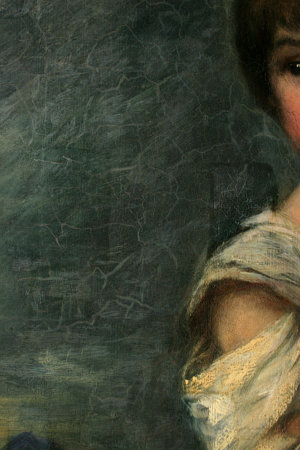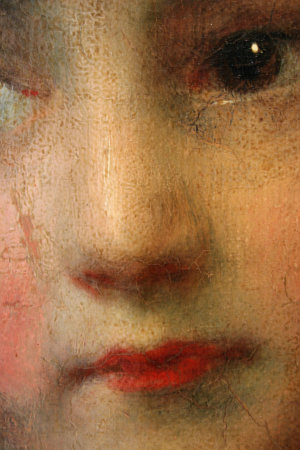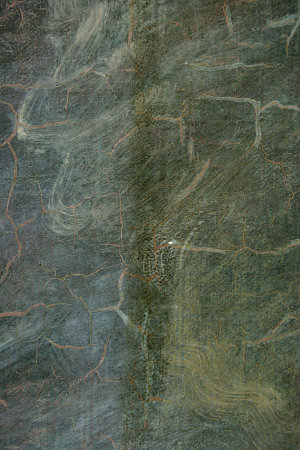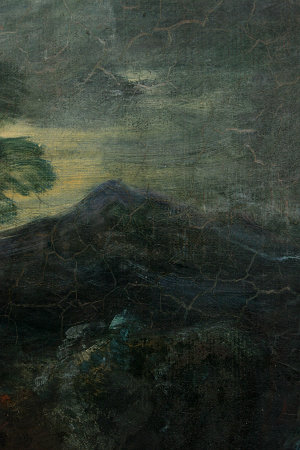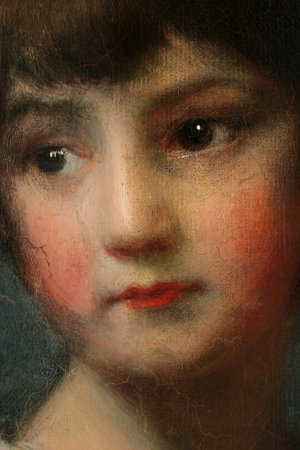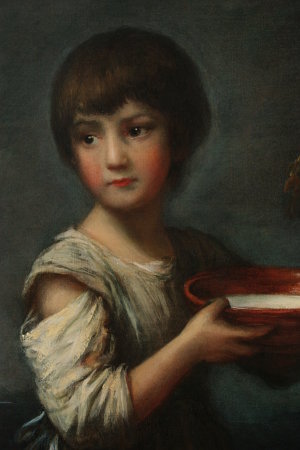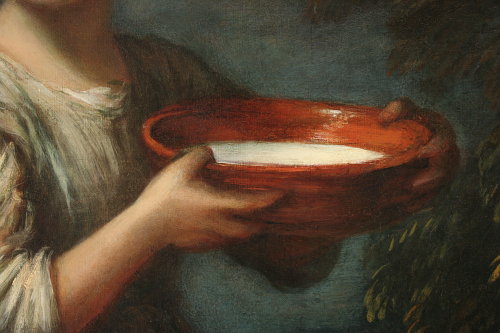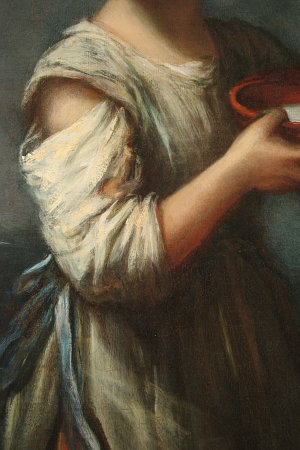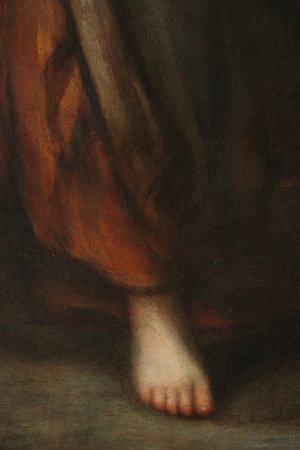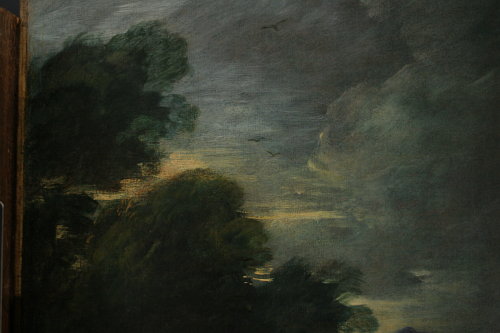(1722 – 1788)
Title:
Lavinia (The Milk Maid)
Date: 1786
Signature: Not present
Accession No: 1585
Dimensions: 150.5 x 119.5 cm
Frame: Wooden, ornate gesso moulded, gilded
Condition Report
Secondary Support
The secondary support is a 7-member mortise and tennon stretcher (W: 9cm T: 2cm). All 14 keys are present. It is suspected that this is a replacement stretcher, partly because it appears more modern than 1786 and because it was a common practice to replace stretchers in the lining process during the 18th and 19th centuries. The condition of the stretcher is good.
Two labels, located on the bottom left hand side of the lower cross member, read:
“JAMES BOURLET & SONS, LTD,
17 & 18 Naussau Street, Mortimer Street, W.1
FRAME DAMAGED WHEN RECEIVED
Date: 27.1.46 From: Condover
Signature: Hawanfield (?)”
The label is printed in red ink and the information after the “date”, “from” and “signature” is hand written in pencil.
The second label is upside down, to the left of the first label and printed in black ink and reads;
“James Bourlet & Sons, Ltd
Fine Art Packers, Frame Makers
C23534
18 &19 Naussau Street
Mortimer Street W.
Phone: - Museum 1871 & 7538”
Primary Support
The primary support is a medium-weight tabby weave linen canvas. This canvas is typically used by Gainsborough and the majority of his contemporaries.
The lining canvas is of finer weight. It has been composition lined and the original tacking margins removed. On the sides of the original canvas one can see cusping and this is particularly apparent on the right hand side. There is an extended “c” shaped tear (dimensions of tear 1 x 2 x 3.5 cm), 30 cm from the top and 35 cm from the right hand side.
Ground
The ground appears to be a shade of orange-pink. Gainsborough usually chose a shade of orange or grey ground, that would be applied either in one or two layers. On occasion he overlaid this with a pinky-beige colour. It is not certain if this ground is a flat colour applied in one or two layers or if it has an imprimatura layer. During this period the majority of British painters were using a grey ground, the introduction of which Bardwell attributes to Sir Godfrey Kneller. Most of the grounds, whatever the colour, display a minutely ridged surface where regular, parallel striations run either vertically or horizontally. Many contemporary English grounds are similar and there would be little significance in this except that paint as thin as Gainsboroughs’ can become abraded along the ridges. This cannot be seen clearly in this work, however the paint layer has been abraded in previous cleaning and the ground is exposed in numerous areas. This is seen particularly clearly in the sky. The overall condition of the ground is good with the exception of the loss in the area of the tear.
Paint Layer
The paint layer is applied in thin layer washes using a brush. Extensive drying cracks can be seen over the entire work. Gainsborough’s paint was slow drying and did not contain an added siccative. He used resinous glazes in his late paintings and often added asphaltum, a coal tar derivative with a very slow drying time that remains sensitve to solvents even after may decades. Varnish removal is thus very complex as both the paint and varnish layer are solvent sensitive due to the resins added. Retouchings consequent to previous cleaning are revealed in the hollows of the contraction, instead of the original paint (see conservation records under “Varnishes”). It is evident that it was not found possible to remove the varnish without disturbing the glazes and the painting subsequently suffered abrasions and loss.
Gainborough had a remarkable ability to make paint sparkle. He achieved this effect by exploiting the fact that most pigments have a crystalline form and therefore have a capacity to reflect and refract light as well as provide colour. Of the range of pigments available in his time, he chose a large proportion of the translucent varieties for his mixtures and favoured keeping them coarsely ground so that they may catch the light more easily. To prevent them from being lost in an opaque matrix, he used large amounts of translucent and transparent fillers, one of which, ground glass, is present in significant amounts.
His paint mixtures are complex and this can be seen in studies of some examples. His blue skies are made up from mixtures of the following pigments:
lead white, Prussian blue, terre verte, Napels yellow, ochres, siennas and sometimes vermilion, black and Cologne earth.
Greyer skies use black (bone or charcoal) as principal pigment, while ground Prussian blue and terre verte are often present too, in addition to pink lake, white lead, calcite and all other pigments listed for blue sky.
Yellow-green grass is analysed as consisting of mainly a mixture of
Terre Verte, with yellow and orange ochres, lead white, Naples yellow, yellow lake, black, Cologne earth and a trace of Prussian blue.
It is not known if Gainborough applied any preparatory under-layer of paint or if he conceived the work as a complex series of coloured tones, all applied separately and directly with brushwork that describes the form, as was his normal practice.
The paint layer appears to be in a sound condition although there is loss in the area of the tear. However, the overall condition of the paint layer is very thin. The painting has been previously cleaned and it is through this that the paint layer would have been abraded. Extensive retouching can also be seen, and these are particularly discoloured in the sky area. Amongst records of previous conservation treatment, an undated correspondence between Roberts and Ehrich, from the Roberts file, National Portrait Gallery (London) reads:
It is true, Mr. Roberts, that the picture was bought but at a small price at public auction, but it was so covered with dirt and old varnish as to be hardly recognizable which made it pure speculation, and in times like these, pictures which are speculative, before cleaning, frequently sell at very small prices. For instance, we bought several dirty pictures in the A.J. Sully sale for 5% of the price at which Mr. Sully offered them to us in London a few years previously…
In a later undated, signed letter Charles Holmes observes:
“If some retouching could be removed (which should not be difficult) the picture would prove, I think, to be an almost perfect specimen of the artist’s romantic pastorals.”
Varnish
The painting is covered by a layer of surface dirt and discoloured varnish. Under ultra-violet light it appears to fluoresce a milky green colour indicating that it is a natural resin varnish.
Treatment report
Photographic record of the painting, front, back and details were taken prior to treatment beginning and a written report was completed.
Following extensive tests, the surface dirt was removed using an appropriate reagent. The varnish was removed in the sky using an organic solvent. In the area of the landscape and figure the varnish was thinned to retain as much of the re-touchings as possible, (see photographic records).
The back of the painting was cleaned and dirt was removed from between the canvas and the stretcher bar.
An isolating brush conservation varnish was applied that does not yellow over time. The losses were in-painted with stable materials to blend with surrounding areas. A final varnish was then applied.
To secure the painting in the frame, the rebate of the frame was first lined with felt, then the painting was fitted, a Fome-cor backboard put in place and the painting secured using flexible brass plates.
Discoveries during treatment
The light pinkish ground that Gainsborough applied to the canvas before beginning to paint was much more visible in thinly painted areas, such as the sky. The tiny white, opaque dots now prominently visible in the sky and seen in other paintings by Gainsborough testify to the artist’s habit of grinding his pigments coarsely.
Museum visitors will once again be able to enjoy Gainsborough’s materspiece as it was meant to be seen. The removal of the dull, murky varnish and over-paint has revealed a more convincing sense of space in the painting.
PROVENANCE:

The painting was painted during 1786 (2 years before his death), when Gainsborough was painting and exhibiting at Schomberg House, Pall Mall.
The painting was first exhibited (untitled) at the Gainsborough Gallery, Schomberg House, 1786, where a dispute arose over the child’s sex. The model for the girl was Jack Hill, the peasant boy who appears in many of Gainsborough’s genres and fancy pictures of this period
The following year it was exhibited at the Liverpool Society for the Promoting of the Arts of Painting and Design, as A Village Girl with Milk. It is thought that this is the artists’ title.
In 1788, it was purchased by Thomas Macklin, London, for ÂŁ300. That year the owner exhibited it at Macklin new Poets Gallery, a gallery for paintings illustrating British poets. It is not certain if the artist or the owner of the painting changed the title to Lavinia.
Lavinia is described in the section on Autumn, in the poem Seasons by James Thomson,1730. In the
….”The lovely young Lavinia once had friends;
and fortune smiled deceitful on her birth.
For, in her helpless years deprived of all,
Of every stay save innocence and Heaven,
She, with her widowed mother, feeble, old,
And poor, living in a cottage far retired”…
The poem was popular at the time. It was pointed out at the time, that neither of the Gainsborough’s paintings on the exhibition was particularly appropriate as a literary illustration.

This Gallery continued to 1801 and in this time he published several portfolios of engravings illustrating various poems. In a series titled Poetic Description of Choice and Valuable Prints, an engraving was included of this painting, by Bartolozzi, 1790, at a cost of ÂŁ250. This was titled, Lavinia. A print of this engraving is part of the Bailey collection at the SA National Gallery.
In May 31, 1799 it was purchased by J. Willett-Willett, for ÂŁ152 5 s.Od, as Cottage Girl. It is thought he is depicted in the Portrait titled J. Willett by George Romey, Bailey Collection, SA National Gallery. n this time it was engraved in Mezzotint by John Whessel, 27 x 19.5 ins. As The Cottage Girl, 1806.
In 1813, it was auctioned at the sale of Willett’s collection by Coxe & Co., where it appears as A peasant girl with dish of milk. It was sold for £157 10 s 0d, and bought by Rogers, the poet, who still possessed it in 1814 when loaned to the Gainsborough Exhibition at the British Institution. When exhibited Benjamin West criticized the painting of the girls’ hair and so Rogers sold the work to Sir George Phillip for 170 gns, 1816.
The painting remained in the Phillip’s family until 1918.
In 1918, Leggatt Bros., sold it directly to Sir Abe Bailey. A photograph dating from this time is in the Witt Library. In 1941, this painting was included in his bequest to the SA National Gallery.
The painting has been illustrated in The Burlington Magazine, Sep. 1941 and
Waterhouse’s Gainsborough, 1958
A further crude engraving by either Rogers or Lupton, is preserved in Roberts files at the National Portrait Gallery, London. On the back of this is written in pencil: Little cottage girl with pan of milk.
What appear to be a full-size copy of the painting was exhibited at Grosvenor Galleries in 1885 as The Milk Girl, lent by Col. Sir Francis Bolton, 1918. This was sold at the same time the SA National Gallery work was on the market.
A further reduced copy was owned by Lord Lawrence of Kingsgate and sold at Christies, 1935. This is possibly an engraver’s version reduced by Gainsborough Dupont. It was illustrated in the Art Digest, December 1935, in an advertisement and a photograph of his is in Roberts files in the National Portrait Gallery.
Reynolds must have known this painting when it was in Macklin’s Gallery. It is interesting to note, considering Reynolds’s jealousy of Gainsborough that when he was invited to contribute to Macklin’s Poets Gallery after Gainsborough’s death, he chose a subject from Thomson’s Autumn.
 The painting was painted during 1786 (2 years before his death), when Gainsborough was painting and exhibiting at Schomberg House, Pall Mall.
The painting was painted during 1786 (2 years before his death), when Gainsborough was painting and exhibiting at Schomberg House, Pall Mall.  This Gallery continued to 1801 and in this time he published several portfolios of engravings illustrating various poems. In a series titled Poetic Description of Choice and Valuable Prints, an engraving was included of this painting, by Bartolozzi, 1790, at a cost of ÂŁ250. This was titled, Lavinia. A print of this engraving is part of the Bailey collection at the SA National Gallery.
This Gallery continued to 1801 and in this time he published several portfolios of engravings illustrating various poems. In a series titled Poetic Description of Choice and Valuable Prints, an engraving was included of this painting, by Bartolozzi, 1790, at a cost of ÂŁ250. This was titled, Lavinia. A print of this engraving is part of the Bailey collection at the SA National Gallery.